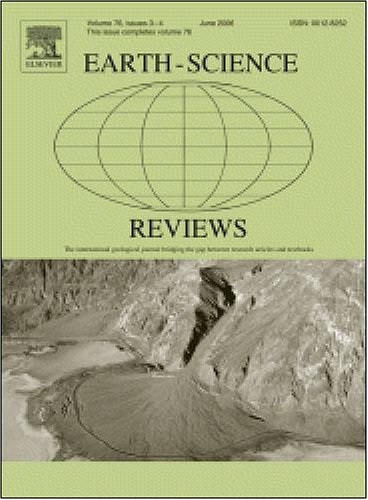Lithospheric architecture and evolution of the Qinling Orogen of Central China and associated controls on metallogeny
IF 10.8
1区 地球科学
Q1 GEOSCIENCES, MULTIDISCIPLINARY
引用次数: 0
Abstract
Orogenic events are not only of importance for the geological evolution of regions and continents but are also significant controls on the formation timing, genesis, and nature of the mineral deposits hosted by the resulting orogen. This study highlights the use of multi-proxy elemental and isotopic mapping of granitoids to advance our understanding of lithospheric architecture and the formation of large-scale mineral systems associated with orogenic events. Here, we combine and review regional multi-proxy element–isotope systematics and the spatial and temporal relationships between granitic magmatism and mineral deposit formation within the Qinling Orogen of Central China. The collation of these data allows the modeling of the evolution of Triassic lithospheric architecture of the orogen and its controls on metallogenesis in this region. The Qinling Orogen is divided into eastern, middle, and western segments by two north-south trending lithospheric discontinuities located at 103°E–104°E and 107°E–108°E. Spatial variations in the Nb–Ta–Zr–Hf elemental and Sr–Nd–Hf isotopic compositions of Triassic granitoids throughout this region provide insight into the heterogeneity of mantle and crust material within this region, as well as the interaction between crust and mantle derived melts within the Qinling Orogen. The orogenic Au and porphyry Cu and/or Mo mineralization within this region is also concentrated along lithospheric discontinuities. These include granitoid-hosted porphyry Cu deposits that cluster and are localized within older crustal material with the most enriched Sr–Nd–Hf isotopic compositions and low Nb/Ta ratios, suggesting the crucial role of fertile metasomatic lithospheric mantle in the formation of these porphyry Cu systems. In comparison, porphyry Mo/Mo–Cu deposits are generally located in areas with younger basement material that has been reworked multiple times, suggesting that intense crust–mantle interaction promotes the reworking of ancient crustal material, which mobilized Mo within the older crustal material to be incorporated into porphyry Mo systems. The links between tectonism, orogenic processes, and metallogeny within the Qinling Orogen outlined in this review not only provide insights for future exploration within this region but also in other orogenic systems globally, highlighting the importance of incorporating orogenic and tectonic processes in mineral systems and exploration targeting.
秦岭造山带岩石圈构造与演化及其对成矿的控制作用
造山带事件不仅对地区和大陆的地质演化具有重要意义,而且对造山带所承载的矿床的形成时间、成因和性质也具有重要的控制作用。本研究强调使用花岗岩类的多代理元素和同位素填图来促进我们对岩石圈结构和与造山事件相关的大型矿物系统形成的理解。本文结合并评述了秦岭造山带区域多代元素同位素系统以及花岗质岩浆活动与矿床形成的时空关系。通过对这些数据的整理,可以模拟该地区造山带三叠纪岩石圈结构的演化及其对成矿的控制作用。秦岭造山带被位于103°E - 104°E和107°E - 108°E两个南北走向的岩石圈不连续性划分为东、中、西三段。整个地区三叠纪花岗岩类Nb-Ta-Zr-Hf元素和Sr-Nd-Hf同位素组成的空间变化,为揭示该地区地幔和地壳物质的非均质性以及秦岭造山带壳幔熔融体的相互作用提供了线索。区内造山带金、斑岩型铜、钼矿化也沿岩石圈不连续面集中。其中包括花岗岩型斑岩型铜矿床,这些斑岩型铜矿床聚集并定位于具有最富Sr-Nd-Hf同位素组成和低Nb/Ta比率的古老地壳物质中,表明丰富的交代岩石圈地幔在这些斑岩型铜矿系统的形成中起着至关重要的作用。相比之下,斑岩型Mo/Mo - cu矿床一般位于较年轻的基底物质经过多次改造的区域,表明强烈的壳幔相互作用促进了古地壳物质的改造,使旧地壳物质中的Mo被动员到斑岩型Mo体系中。本文总结了秦岭造山带构造作用、造山作用和成矿作用之间的联系,为今后在该地区以及全球其他造山带的找矿提供了参考,强调了将造山作用和构造作用结合到成矿系统和找矿目标中的重要性。
本文章由计算机程序翻译,如有差异,请以英文原文为准。
求助全文
约1分钟内获得全文
求助全文
来源期刊

Earth-Science Reviews
地学-地球科学综合
CiteScore
21.70
自引率
5.80%
发文量
294
审稿时长
15.1 weeks
期刊介绍:
Covering a much wider field than the usual specialist journals, Earth Science Reviews publishes review articles dealing with all aspects of Earth Sciences, and is an important vehicle for allowing readers to see their particular interest related to the Earth Sciences as a whole.
 求助内容:
求助内容: 应助结果提醒方式:
应助结果提醒方式:


